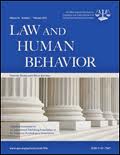Discussion of trial evidence by jurors, prior to jury deliberation, can introduce a systematic bias in jury verdicts. This is the bottom line of a recently published article in Law and Human Behavior. Below is a summary of the research and findings as well as a translation of this research into practice.

Featured Article | Law and Human Behavior | 2018, Vol. 42, No. 5, 413-426
Should Jurors Be Allowed to Discuss Trial Evidence Before Deliberation?: New Research Evidence
Author
Norbert L. Kerr, Michigan State University and Claremont Graduate University
Jiin Jung, Claremont Graduate University
Abstract
Traditionally, jurors are not permitted to discuss trial evidence with one another prior to jury deliberation. Allowing such discussions, at least in civil trials, is a jury innovation that has become increasingly popular. Prior field research has generally supported the assumption that this innovation is benign and, in particular, introduces no systematic bias in jury verdicts. These issues are examined again here within an experimental jury simulation study. The opportunity for predeliberation juror discussion (PJD) between the plaintiff and defense cases-in-chief was manipulated. The results revealed that PJD biased jury verdicts. The nature of this bias was not, as commonly suspected, a commitment to evidence heard prior to PJD, but rather a greater weight placed on evidence heard following the PJD. One good explanation of this bias was that jurors acted as if evidence heard prior to PJD had “already been covered” during the PJD, and so primary attention was given to post-PJD evidence in jury deliberations. Little evidence was found to corroborate several other purported benefits or drawbacks of PJD.
Keywords
jury, predeliberation discussion, jury innovation, bias, recency effect
Summary of the Research
“Traditionally, the first real opportunity that jurors have to discuss a trial’s evidence with one another occurs during jury deliberations at the end of the trial. Indeed, jurors are routinely instructed at the outset of the trial that they must not discuss the trial evidence with anyone— fellow jurors, friends, or even a spouse—before such deliberations begin. The primary reason for this prohibition is a concern that such discussions could lead jurors to make up their minds about the key issues in the case prematurely—that is, before they have heard all the evidence or been instructed on the law governing their verdicts” (p. 413).
“However, in the last few years a number of states (e.g., Arizona, Colorado, the District of Columbia, Indiana, Maryland, Michigan) have relaxed this prohibition, permitting jurors to discuss the evidence prior to deliberation under certain conditions. For example, in Arizona civil trials jurors are now permitted to discuss the evidence during trial recesses, but only among themselves in the jury room and only when all jurors are present. Furthermore, jurors are cautioned that they must not form final opinions about any fact or about the outcome of the case until they have heard and considered all of the trial evidence. A number of other states (e.g., California, North Dakota) have actively considered making similar changes to their procedures. Others (e.g., Anderson, 2002) have called for permitting such discussion to occur in criminal or military juries as well. And there are indications that even in states where predeliberation discussion is prohibited, judges are allowing it if counsel consent” (p. 413-414).
“The general structure of trials require that one side present its case before the other—defendants cannot answer charges until the plaintiff/prosecution first present their case. If jurors have heard one side (e.g., the plaintiff’s) first, and then discussed the case before hearing the other side (e.g., the defendant’s), prejudgment and early commitment would appear to advantage the plaintiff in civil trials (and the prosecution in criminal trials). This reasoning has reasonably made a prediction of a type of “primacy effect” (viz., more verdicts for the side presenting first, the plaintiff or prosecution) in prior PJD [predeliberation juror discussion] research the most popular alternative to the null hypothesis (i.e., same verdicts in juries permitted and forbidden to discuss). But an opposite, “recency effect” could also be predicted. For example, if jurors tended to discount, ignore, or underweigh in final deliberations evidence presented prior to their discussions (which would tend to favor the side that presents first) for any of several reasons (e.g., “we’ve already covered that”; more confidence in one’s evaluation of evidence after an opportunity to socially validate one’s understanding of evidence heard prior to discussion), then a recency/prodefense effect would result” (p. 415).
“Both of these predictions also make a simplifying but questionable assumption—that each side’s prospects for winning the trial hinge primarily on the evidence presented in each side’s case-inchief (i.e., during the early plaintiff/prosecution case or the late defense case). Although this may often be true, at the end of the trial it is not the relative strength evidence presented early versus late that is crucial, but rather the relative strength of the totality of each side’s supporting evidence that should determine the trial outcome. This means that a primacy effect— greater weight placed on information presented early—need not result in more proplaintiff/prosecution verdicts, and that a recency effect— greater weight placed on information presented late—need not result in more prodefense verdicts. For example, suppose in a civil trial the plaintiff’s case-in-chief is much weaker than the defense’s casein- chief. A primacy effect might manifest itself as highlighting the weakness of the plaintiff’s case, and hence lead to more prodefense verdicts. Conversely, a recency effect might result in more proplaintiff / prosecution verdicts if the defense case-in-chief were extremely weak” (p. 415-416).
“The primary objective of this article was to explore whether predeliberation juror discussion (PJD) is verdict neutral—that is, whether such discussion has no systematic impact on juror/jury verdicts, as the prior literature has suggested, or whether such discussion does have some impact. Our results clearly indicated that PJD is not verdict neutral, at least under the conditions examined here. The impact of PJD on verdicts was significant and strong (e.g., overall, the difference in jury pro-plaintiff-verdict rates between those denied and permitted PJD was 26.5%). However, the effect of PJD was not a simple proplaintiff/proprosecution bias, as has been suspected in most prior commentary and research. Rather, the effect of PJD was a type of recency effect— the evidence presented later in the trial (and after the jury’s PJD) had relatively greater impact on the jury’s verdict than the evidence presented early in the trial (and prior to the jury’s PJD). This kind of recency effect would not produce a simple proplaintiff or prodefense bias unless the timing of evidence (early vs. late in the trial, and hence, usually before vs. after PJD) was strongly correlated with which side the evidence favored (plaintiff vs. defendant). It may well be true that the strongest plaintiff evidence often appears early (during the plaintiff’s case-in-chief) and the strongest defense evidence often appears late (during the defense’s case-in-chief). But it is also quite possible for the opposite to occur—strong defense evidence appearing early or strong plaintiff evidence appearing late—or for there to be no clear correlation between timing and side favored. If across all trials, this correlation were weak or absent, we would not expect any net effect of PJD on verdict, which is just the general pattern observed in the prior field research. Our experimental design permitted us to tease apart the timing of strong evidence (early vs. late) and the side favored by that evidence (plaintiff vs. defense). And our results suggest that the net effect of permitting PJD will be to bias verdicts in favor of whichever side would profit more from the jury paying greater attention and giving greater weight to the evidence presented after PJD than before PJD” (p. 422).
Translating Research into Practice
“For the sake of argument, let us momentarily assume that the recency bias found here will occur for a wide range of civil (or criminal) trials; what might be done to minimize it? If it could be shown that some ways of timing PJD were less likely to produce the bias (e.g., regular and frequent PJDs), perhaps juries might be encouraged or required to time their discussions accordingly. However, the evidence for such an ideal patterning of discussions would have to be compelling to justify such an intrusive remedy. Judges instructions might describe the bias and caution the jury not to consider evidence discussed during a PJD session as “already covered” and hence, worth less consideration during their final deliberations. Unfortunately, the research evidence on the effectiveness of such cautionary judicial instructions is not encouraging. Pending the research required to understand the full impact of permitting PJDs, and the effectiveness of alternative remedies, the safest option would appear to be to follow the long-standing tradition of prohibiting PJD” (p. 424).
“There are many trial practices which jurors dislike, such as being denied information on a defendant’s past criminal history, being denied access to sidebar conversations, or reaching verdicts without knowing exactly what sentence might be imposed. But in these and many other practices, the goal of unbiased jury decision making trumps juror preferences. Our results suggest that prohibiting predeliberation juror discussion might well be another such practice, and that the rush to implement this jury innovation should be reconsidered” (p. 425).
Other Interesting Tidbits for Researchers and Clinicians
“An ever-present issue for experimental jury simulation studies like this one is whether the key findings would be materially different under more realistic conditions (e.g., a more representative jurors; with a live trial; if the verdicts determined tangible consequences for the litigants). Fortunately, there is practically no evidence that results from mock jury simulation studies are materially altered by increasing realismalong such dimensions. A separate issue is the particular form the PJD took in our study—a brief discussion of the evidence between the two cases in chief. Of course, there are many other forms that PJD might take in actual trials, and some of these seem likely to modify the recency effect we observed. For example, the closer the last juror discussion occurred to the start or the end of the trial, the less impact a greater focus on the postdiscussion evidence should have. At the limits, all/none of the trial evidence would remain to be heard if there were only a single discussion at the start/end of the trial. And the length of a trial or of a jury’s discussion might well affect any recency bias; for example, the shorter the discussion, the harder it would be to maintain that the jury had “already covered” all the evidence presented prediscussion. Also, for good experimental reasons, our mock juries only considered trials in which the cases-in-chief for both sides were nicely balanced. But if there were a strong contrast between the strength of the plaintiff’s and the defense’s cases, the recency bias might be altered—it might be attenuated / bolstered if the defense case were patently weaker/stronger than the plaintiff case. Clearly, much more research is required to settle such external validity questions” (p. 424).
Join the Discussion
As always, please join the discussion below if you have thoughts or comments to add!





















